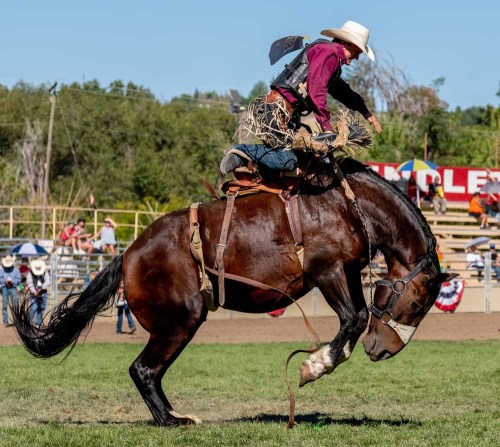Pendleton Round-Up livestock also are athletes
Published 5:30 am Thursday, September 12, 2024

- Ryder Sanford of Sulphur, Louisiana, rides Sweet Sixteen during the Saddle Bronc competition and scores 83.5 points Wednesday, Sept. 13, 2023, on the opening day of Pendleton Round-Up in the Pendleton Round-Up Arena.
PENDLETON — Fans at the Pendleton Round-Up see top rodeo athletes in rough stock events giving it their all.
But this isn’t about the cowboys.
Those bucking broncos and bulls are every bit the athletes as the cowboys struggling to ride them.
For the Round-Up’s three rough stock events — bareback riding, saddle bronc riding and bull riding — the Round-Up works with several contractors to provide bucking stock.
Justin Terry, the Round-Up’s livestock director, said good bucking stock is simple to define.
“Experienced animals that buck hard every trip,” he said.
Keith Marrington is a key stock contractor for the Calgary Stampede, one of North America’s biggest rodeos held each summer in Alberta. He also provides bucking stock for various rodeos across North America, including the Canadian National Championship Rodeo and the National Finals Rodeo.
Marrington has supplied bucking stock for the Pendleton Round-Up for the past 12 years.
For Marrington, the quality of bucking stock comes down to several things, including the breeding and program used. His organization has 70 years of experience in raising and developing bucking stock.
“We try to breed good stock while also taking great care of the animals,” Marrington said.
Pat Beard from Pendleton is a local with experience in producing rough stock. His family has been involved in rodeos since the 1940s, when his grandfather, Johny Van Belle, promoted rodeos and produced bucking stock. Until 2003, Pat’s family continued this tradition with the Beard Rodeo Co.
Beard said good rough stock is all about raising animals that naturally want to buck.
“They have to want to buck and have that desire,” he said.
Beard compared raising rough stock to raising racehorses, as both need a strong purpose and drive.
Genetics also matter. Many of the best rough stock horses come from the famous Chandler Earl “Feek” Tooke breeding program.
Tooke started breeding horses in the late 1930s on his family’s ranch in Ekalaka, Montana. He and his son, Ernest, used registered Shire stallions with cross-bred mares to create a new breeding program, producing more than 6,000 rodeo broncs. Tooke’s program had a big impact on rodeo stock in North America and remains influential today.
In addition to genetics and a good pedigree, training is key. Before a rider gets on, dummies are used to help the animals learn to buck, turn and step.
Overall, creating great bucking stock involves respecting traditions while using modern methods and ensuring the animals’ well-being. As rodeos such as the Pendleton Round-Up continue to thrill audiences, the dedication of stock contractors and breeders helps keep these exciting events going strong.





